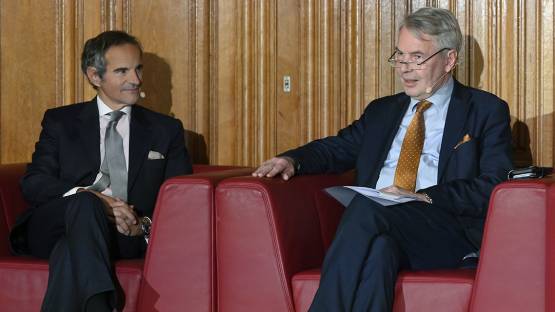At the 14th Symposium on International Safeguards, underway this week at IAEA headquarters in Vienna, participants have been reflecting on experience gained and lessons learned over the course of six decades of implementation of nuclear safeguards; to verify that States are honouring their international legal obligations to use nuclear material and technology only for peaceful purposes. Today, the IAEA applies safeguards in nearly 190 States around the world.
This year marks two important anniversaries for nuclear verification: 50 years since the entry into force of the first comprehensive safeguards agreement (CSA) and 25 years since the entry into force of the first Additional Protocol (AP).
“The IAEA’s official commitment to verify nuclear material while aiding and assisting in the development of peaceful nuclear technologies accurately reflects the fundamentally dual nature of atomic energy,” said Richard Rhodes, historian and Pulitzer Prize-winning author, in his keynote speech to the Symposium entitled ‘A Past Full of Promise’.
The Safeguards Symposium, held every four years, brings together global stakeholders in support of IAEA safeguards. During this week, Safeguards regulatory authorities from IAEA member countries, the research and development community, industry and civil society are identifying challenges and opportunities for IAEA safeguards, showcasing research, sharing ideas and building partnerships.
At a Symposium event hosted by the Mayor of Vienna and sponsored by the Nuclear Threat Initiative yesterday, a high-level panel convened at the historic Vienna City Hall. IAEA Director General Rafael Mariano Grossi was joined on the panel by HE Haavisto, Finland’s Minister for Foreign Affairs; Ambassador Luis Javier Campuzano Piña, Resident Representative to the IAEA, Permanent Mission of the United Mexican States; Ambassador Susan Eckey, Resident Representative to the IAEA, Permanent Mission of the Kingdom of Norway; and Geoffrey Shaw, Director General of the Australian Safeguards and Non-Proliferation Office. Norway received the first IAEA inspection in 1962; Mexico concluded the first safeguards agreement applied to all of a country’s nuclear activities in 1968; Finland brought into force the first CSA in connection with the Treaty on the Nonproliferation of Nuclear Weapons (NPT), in 1972; and the first AP entered into force for Australia in 1997.
"What drove us to be a ‘fast mover’ was that Finland really wanted to have international safeguards for our peaceful nuclear programme, instead of bilateral safeguards arrangements with nuclear supplier countries," said Mr Haavisto. “Strengthening the IAEA's safeguards is a very topical issue and has Finland's full support. We commend the IAEA’s work in all its aspects."
The NPT, and the ensuing comprehensive safeguards agreements, mean that the IAEA is responsible for safeguarding all nuclear material in those non-nuclear weapon States that are party to the treaty. Early safeguards focused on verifying declared nuclear material at declared facilities, but the discovery of undeclared nuclear activities in Iraq in the 1990s revealed limitations in this approach. To strengthen the system, IAEA Member States developed a new agreement known as the Additional Protocol, which greatly improved the IAEA’s ability to detect undeclared nuclear material and activities, by broadening the Agency’s access to information and locations for verification. Today, 140 States have an AP in force, with the latest concluded between Sierra Leone and the Agency on Monday, the first day of the Symposium.
“The years, 1990 to 1997, were positive for safeguards, with the first legal instrument in 25 years,” said Laura Rockwood, former Section Head for Safeguards in Office of Legal Affairs, IAEA. “Constant communication with IAEA Member States, together with competent and imaginative leadership, were key to those successes. That unity of purpose among Member States and the IAEA is required again to tackle the challenges of today.”
Still to come at the Symposium this week, participants will hear from a panel of young professionals in discussion with Massimo Aparo, IAEA Deputy Director General and Head of the Department of Safeguards, about the possible technological needs, anticipated skill requirements and forecasted verification approaches for safeguards in the future.
The conference is being livestreamed through the IAEA Conferences and Meetings app, available on the App Store and Google Play. Follow the IAEA and #IAEASG2022 on Facebook, Twitter, Instagram and LinkedIn for updates throughout the week.
Click here for more information about the Symposium.






